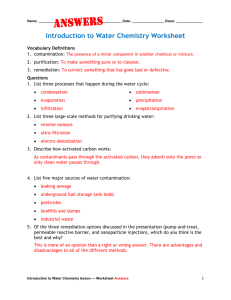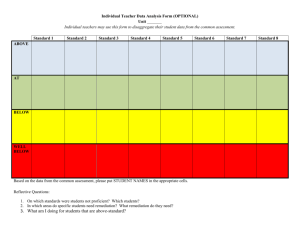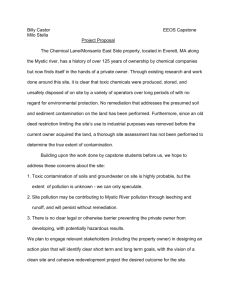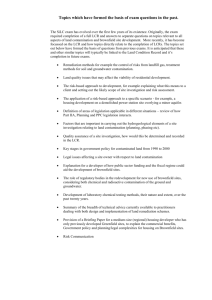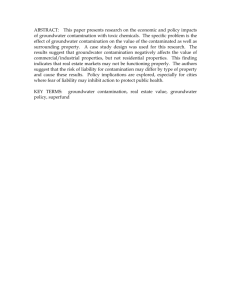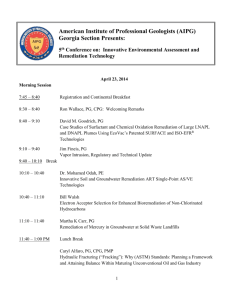T Case Studies Analysis: Environmental Stigma and Monitored Natural Attenuation
advertisement
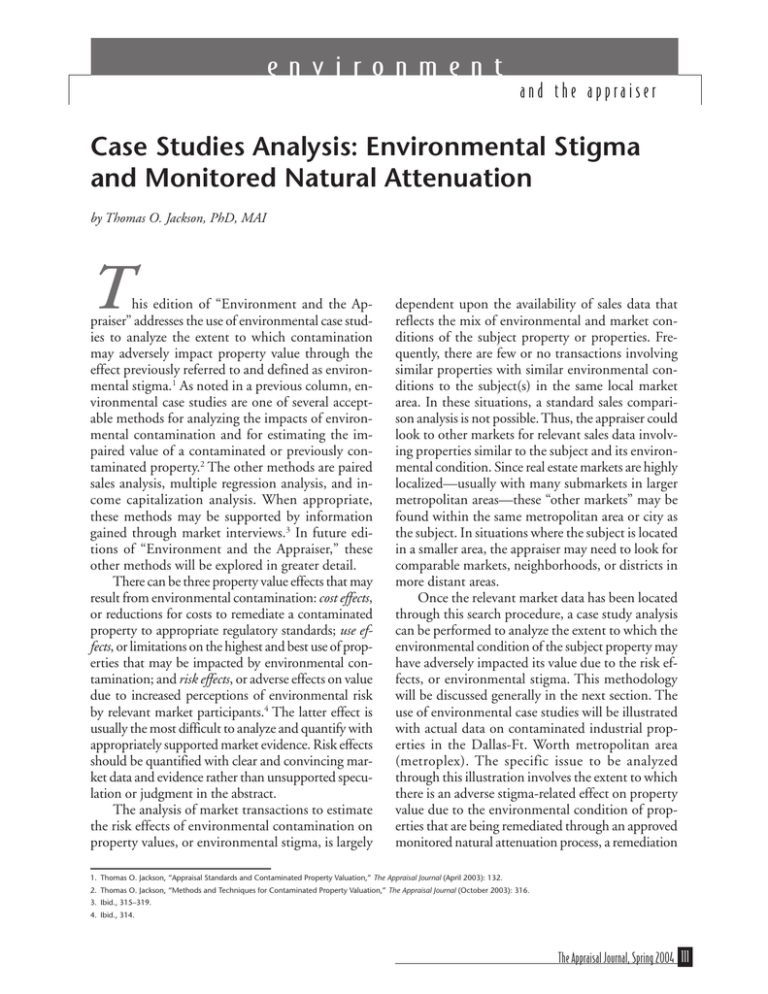
e n v i r o n m e n t and the appraiser Case Studies Analysis: Environmental Stigma and Monitored Natural Attenuation by Thomas O. Jackson, PhD, MAI T his edition of “Environment and the Appraiser” addresses the use of environmental case studies to analyze the extent to which contamination may adversely impact property value through the effect previously referred to and defined as environmental stigma.1 As noted in a previous column, environmental case studies are one of several acceptable methods for analyzing the impacts of environmental contamination and for estimating the impaired value of a contaminated or previously contaminated property.2 The other methods are paired sales analysis, multiple regression analysis, and income capitalization analysis. When appropriate, these methods may be supported by information gained through market interviews.3 In future editions of “Environment and the Appraiser,” these other methods will be explored in greater detail. There can be three property value effects that may result from environmental contamination: cost effects, or reductions for costs to remediate a contaminated property to appropriate regulatory standards; use effects, or limitations on the highest and best use of properties that may be impacted by environmental contamination; and risk effects, or adverse effects on value due to increased perceptions of environmental risk by relevant market participants.4 The latter effect is usually the most difficult to analyze and quantify with appropriately supported market evidence. Risk effects should be quantified with clear and convincing market data and evidence rather than unsupported speculation or judgment in the abstract. The analysis of market transactions to estimate the risk effects of environmental contamination on property values, or environmental stigma, is largely dependent upon the availability of sales data that reflects the mix of environmental and market conditions of the subject property or properties. Frequently, there are few or no transactions involving similar properties with similar environmental conditions to the subject(s) in the same local market area. In these situations, a standard sales comparison analysis is not possible. Thus, the appraiser could look to other markets for relevant sales data involving properties similar to the subject and its environmental condition. Since real estate markets are highly localized—usually with many submarkets in larger metropolitan areas—these “other markets” may be found within the same metropolitan area or city as the subject. In situations where the subject is located in a smaller area, the appraiser may need to look for comparable markets, neighborhoods, or districts in more distant areas. Once the relevant market data has been located through this search procedure, a case study analysis can be performed to analyze the extent to which the environmental condition of the subject property may have adversely impacted its value due to the risk effects, or environmental stigma. This methodology will be discussed generally in the next section. The use of environmental case studies will be illustrated with actual data on contaminated industrial properties in the Dallas-Ft. Worth metropolitan area (metroplex). The specific issue to be analyzed through this illustration involves the extent to which there is an adverse stigma-related effect on property value due to the environmental condition of properties that are being remediated through an approved monitored natural attenuation process, a remediation 1. Thomas O. Jackson, “Appraisal Standards and Contaminated Property Valuation,” The Appraisal Journal (April 2003): 132. 2. Thomas O. Jackson, “Methods and Techniques for Contaminated Property Valuation,” The Appraisal Journal (October 2003): 316. 3. Ibid., 315–319. 4. Ibid., 314. The Appraisal Journal, Spring 2004 111 environment and the appraiser process that is being used more frequently across the United States. Overview of Case Studies Methodology Jackson and Bell offer an in-depth look at environmental case studies and the elements that should be considered in a case studies analysis.5 As they state, “the central message here is that ‘apples to apples’ comparisons must be made, and that a number of specific elements must be considered for a valid and reliable case study analysis.”6 The elements that should, and in some situations must, be considered fall into three general categories: property characteristics, contamination discharge issues (environmental condition), and other/related issues. Each of these categories and the detailed elements of comparison within them are examined next. Property Characteristics Two property-related characteristics that should be considered in the selection and analysis of case study properties are property type and market condition. As with any appraisal assignment involving comparable sales, the properties selected as comparables should be of the same type as the subject property. For example, income-producing commercial and industrial properties are not comparable to owner-occupied residential properties in a nonenvironmental appraisal assignment, and are not appropriate comparables for assignments involving the analysis of contaminated properties. The markets and market participants for properties in these diverse categories have different motivations and will or could be impacted in much different ways and through different market mechanisms. Indeed, empirical research has shown that properties in these categories are impacted differently by the same contamination source.7 Likewise, the comparable case study property should be located in a market area with the same general market conditions as the area in which the subject property or properties are located. The importance of market conditions in the analysis of the impacts of environmental contamination on property values lies in their potential intervening effects. In other words, various market conditions can influence the extent to which contamination impacts property values. Empirical research on environmental risk perceptions has found that strong market conditions tend to mitigate or reduce the adverse impacts of contamination, while weak market conditions tend to exacerbate or increase the impacts.8 Thus, comparability in market conditions between the subject property and the case study property or properties is an important aspect of a reliable case study analysis. Contamination/Discharge Issues (Environmental Condition) The next set of elements is related to comparability between the environmental condition of the subject and case study properties. These elements include: whether or not the property is a source, non-source, adjacent, or proximate property with respect to the release of the contamination; whether the contamination was the result of an accidental or permitted release; the type of contaminant; the level of the contamination; the area bioavailability/risk exposure; and the remediation life-cycle stage of the contaminated or previously contaminated properties. The first element, involving the relationship of the subject property to the source of the contamination that may be impacting its value, categorizes properties as being a source site for the contamination, a contaminated non-source site, an adjacent but uncontaminated property, or an uncontaminated site that is not adjacent but in proximity to the contamination source. The environmental risk and stigma effects will vary considerably by these categories. For example, source sites that must be remediated have a much different set of risk factors than uncontaminated adjacent or proximate sites. The second element, as noted, is whether the contamination was accidentally released or was the result of a permitted release. Accidental releases can involve an enforceable requirement for remediation, with resulting uncertainty about costs, timing, etc., while permitted releases by definition have been approved by the regulatory authorities and are usually not required to be corrected or remediated. 5. Thomas O. Jackson and Randall Bell, “The Analysis of Environmental Case Studies,” The Appraisal Journal (January 2002): 86–95. 6. Ibid., 86. 7. G. William Page and Harvey Rabinowitz, “Groundwater Contamination: Its Effects on Property Values and Cities,” Journal of the American Planning Association 59, no. 4 (Autumn 1993): 473–81; and Mark Dotzour, “Groundwater Contamination and Residential Property Values,” The Appraisal Journal (July 1997): 279–85. 8. Thomas O. Jackson, “Environmental Risk Perceptions of Commercial and Industrial Real Estate Lenders,” Journal of Real Estate Research 22, no. 3 (November–December 2001): 271–288. 112 The Appraisal Journal, Spring 2004 environment and the appraiser The third and fourth elements, type and level of contamination, refer to the specific contamination constituents (petroleum hydrocarbons, chlorinated solvents, etc.), the contamination conveyance (groundwater, soils, etc.), and the level or amount of contamination. Each combination of these elements involves very different types and levels of environmental risk. Related to this is another element termed “area bioavailability.” This refers to the extent to which a particular constituent may actually pose a risk to a receptor (human) through an exposure pathway.9 If there is no exposure pathway or exposure potential, there is little bioavailability and much less or no environmental risk that could produce a stigma effect on property value. The last element pertaining to the comparability of the environmental condition of the subject and case study properties involves their stage in the remediation cycle (before, during, or after cleanup) as of the date of value for the subject property and as of the date of sale for the case study property. Existing empirical research has demonstrated quite different impacts of environmental contamination, risk perceptions, and price effects for each stage in the remediation cycle.10 Generally, the greatest impacts on property values due to increased environmental risk and stigma occur before remediation, when the least is known about the requirements, timing, and costs for site cleanup. As the remediation plan is approved and cleanup commences pursuant to the approved plan, risk and uncertainty decrease. In the third stage, after completion of the approved remediation and achievement of a no further action (NFA) status with respect to regulatory requirements, risk and stigma diminish further and may disappear altogether. This general pattern would apply to source sites as well as contaminated non-source properties, even if the primary remediation activities were at the source site. Thus, the subject property and the comparable case study properties must be in the same stage of the remediation cycle for reliable inferences and a credible case studies analysis. Other/Related Issues Finally, there are a number of other important elements to be considered, some of which may not be applicable in all case study analyses. The first involves the responsibility for cleanup costs. Frequently, the party responsible for the contamination and its remediation will indemnify a prospective buyer and/or lender against future responsibilities for such costs. In many cases, this could significantly reduce the uncertainty and risk associated with these costs. Another element to be considered in a case study analysis is the extent to which there are or will be any limitations on the use of the property due to remediation activities or subsequent to remediation. A further element is the extent to which there are third-party liabilities, such as off-site impacts for source sites, that may influence environmental risk and stigma impacts. Lastly, the date of value for the subject and the date of sale for the case study property should be similar since the market’s experience in dealing with contamination-related issues has varied over time. Two-Step Valuation Process The mechanics of an analysis of environmental case studies typically involve a two-step process.11 The first step would largely follow the preceding discussion in identifying appropriate and comparable case studies that have the same property, environmental, and other characteristics as the subject property or properties. An important intermediate step, though, involves the treatment of projected remediation costs for these properties. Assuming the purpose of the analysis is to estimate the effect of environmental risk and stigma on property value, the prices of the case study property sales should be adjusted for these costs. As explained by Jackson and Bell, the sale prices for source site comparables should be adjusted to remove the effect of future remediation costs where such costs have been reliably estimated. This can be accomplished by adding the estimated costs to be paid by the buyer from property cash flows to the nominal sale price. This would leave an adjusted price that 9. Raymond C. Loehr, “The Environmental Impact of Soil Contamination: Bioavailability, Risk Assessment, and Policy Implications,” Policy Study No. 211, Reason Public Policy Institute (August 1996). 10. Thomas O. Jackson, “Environmental Contamination and Industrial Real Estate Prices,” Journal of Real Estate Research 23, no. 1/2 (January–April 2002): 179–199; Jackson, “Environmental Risk Perceptions of Commercial and Industrial Real Estate Lenders”; and Thomas O. Jackson, “The Effects of Environmental Contamination on Real Estate: A Literature Review,” Journal of Real Estate Literature 9, no. 2 (2001): 93–116. 11. Jackson and Bell, 87; and Thomas O. Jackson, “The Effect of Previous Environmental Contamination on Industrial Real Estate Prices,” The Appraisal Journal (April 2001): 200– 210, see especially 204–206. The Appraisal Journal, Spring 2004 113 environment and the appraiser reflects the risk-related effects of the case study property’s environmental condition on its price as of the date of sale.12 Next, the case study properties are matched with otherwise similar but uncontaminated properties in their local market area in order to determine the extent to which their prices may have been adversely impacted by their environmental condition through paired sales analysis. The second general step would be to compare each of the case studies to the subject property. Proper analysis of the case studies through paired sales will have resulted in an estimated property value diminution. The case studies can then be compared to the subject property based on their comparability on the elements discussed above. A relative comparison analysis can be used for this purpose. As explained in The Appraisal of Real Estate, each element is compared and assigned a rank of superior, inferior, or similar.13 An overall ranking is then made after considering each of the individual comparisons. The overall ranking or net comparison derived from the case studies provides the basis for reconciling a range of indicated impacts on value. This is usually the final step in the case study analysis. In some assignments, however, an additional step is the deduction of the subject property’s estimated future remediation costs that are to be borne by property cash flows and not by the seller or another source, such as environmental insurance or a state reimbursement fund. This step provides a final adjusted estimate of the subject’s impaired value. Case Study Application This section presents an application of the case study methodology. The application involves an improved industrial property in the Dallas-Ft. Worth metroplex. The exact address of this property will be withheld, and the presentation will focus on the analysis of a specific environmental condition rather than the subject property. The purpose of this presentation is to illustrate how case study analysis can be used to analyze a given and factual environmental condition. The resulting analysis can then be ap- plied to a subject property with a similar environmental condition in order to estimate any diminution in value due to the condition. This last step will be discussed but not presented in detail. Monitored Natural Attenuation The environmental condition to be analyzed here is associated with a remediation technique known as monitored natural attenuation. As defined by the U.S. Environmental Protection Agency (EPA), monitored natural attenuation (MNA) is the reliance on natural attenuation processes (within the context of a carefully controlled and monitored site cleanup approach) to achieve site-specific remediation objectives within a time frame that is reasonable compared to that offered by more active methods. The “natural attenuation processes” that are at work in such a remediation approach include a variety of physical, chemical, or biological processes that, under favorable conditions, act without human intervention to reduce the mass, toxicity, mobility, volume, or concentration of contaminants in soil or groundwater. These in-situ processes include biodegradation; dispersion; dilution; sorption; volatilization; radioactive decay; and chemical or biological stabilization, transformation or destruction of contaminants.14 In addition, the EPA notes that other terms for natural attenuation in the literature include “intrinsic remediation,” “intrinsic bioremediation,” “passive bioremediation,” “natural recovery,” and “natural assimilation.”15 Thus, appraisers should recognize these terms as referring to a natural attenuation process that could form the basis for MNA. The basic idea behind MNA is that “natural processes are to be relied upon to achieve cleanup objectives.”16 The EPA is careful to distinguish between cases where MNA is used “as a remedy, as opposed to the case where ‘natural attenuation’ processes are occurring as part of a noaction remedy and are not being relied upon to achieve remedial objectives.”17 In other words, an MNA remediation plan is part of a planned and approved cleanup strategy designed to achieve specific objectives with respect to the contamination rather than 12. Jackson and Bell, 87. 13. Appraisal Institute, The Appraisal of Real Estate, 12th ed. (Chicago: Appraisal Institute, 2001), 459–467. 14. U.S. Environmental Protection Agency, Office of Solid Waste and Emergency Response, Directive 9200.4-17P, Use of Monitored Natural Attenuation at Superfund, RCRA Corrective Action, and Underground Storage Tank Sites (April 21,1999), 3. 15. Ibid., 3–4. 16. OSWER Monitored Natural Attenuation Workgroup, “Underground Storage Tanks, MNA Frequent Question 1,” U.S. Environmental Protection Agency, http://www.epa.gov/ OUST/oswermna/mnafaq1.htm. 17. Ibid. 114 The Appraisal Journal, Spring 2004 environment and the appraiser being part of a “no-action” remedy for the contamination. Further, MNA by definition involves active monitoring of the natural attenuation processes to ensure that remedial objectives are being achieved consistent with the approved plan. In relation to the remediation life cycle previously discussed, the issue is whether MNA might be considered in the during remediation stage or after remediation stage. Jackson has defined the during remediation stage as “cleanup proceeding under a plan that has been approved by applicable regulatory authorities” and the after remediation stage as “after cleanup to applicable regulatory standards.”18 Thus, it would appear that MNA could be considered a during remediation stage process since cleanup is underway and has not been completed. This is an important issue since the market may react differently to the environmental risks associated with a property that is in the during remediation and the after remediation stages. This issue will be addressed in the analysis presented next. Analysis of Case Studies The subject property for this illustrative case study analysis was a single-story, light-industrial building located in an industrial district near the Dallas-Ft. Worth airport.19 A semiconductor manufacturer had previously used the building. An environmental assessment of the property found groundwater contamination consisting of volatile organic compounds (VOCs) assumed to have originated from a waste solvent storage tank that had been previously removed from the site. The elevated levels of VOCs were above the minimum content levels set forth by the Texas Commission on Environmental Quality. For this site, MNA was proposed as the most appropriate remediation method due to the limited area of affected groundwater, the lack of migration pathways, the lack of affected groundwater off-site, and the lack of use of the groundwater. As of the date of value for the subject property, however, the Texas Commission on Environmental Quality had not approved MNA remediation for the subject property. Consequently, the analysis of case studies being remediated through MNA—and the effect of that environmental condition on property value— was undertaken under a somewhat hypothetical condition that the subject’s MNA-based remediation plan had been approved and was underway.20 The Case Study Comparison Chart (Table 1) lists characteristics and relevant elements of comparison of the subject property and four case study properties with relatively similar environmental conditions.21 Most importantly, three of the four properties were being remediated through MNA as of their dates of sale. Three of the four are industrial properties in other submarkets within the Dallas-Ft. Worth metroplex; one was a retail property. Each of the case study properties and their sales were paired with three to four otherwise similar but uncontaminated properties that had sold around the same date and in the same local market area as the case study property. Case Study One. Case Study One involved the sale of a retail building that as of its date of sale was contaminated with petroleum contamination in the soils from a leaking underground storage tank. The seller had initiated a cleanup of the property prior to the sale, but made no indemnifications to the buyer, who assumed full responsibility and all risks subsequent to the sale. Reportedly, the seller had made initial expenditures for remediation, but the state paid for ongoing monitoring. The remedial action plan (RAP) had been approved prior to the sale and consisted of storage tank removal and ongoing monitoring. There was significant area bioavailability/risk exposure due to a domestic water well located within a quarter of a mile from the site. The property had not achieved regulatory closure or no further action (NFA) status at the time of sale. The unit price for this sale of $64.24 per square foot was consistent with a market range for paired sales of similar but uncontaminated properties, which ranged from $45.42 to $75.63 per square foot. A narrower range, established by two of these sales, was $57.44 to $65.44 per square foot. No diminution in value for the case study subject was indicated. As shown in Table 1, elements of similarity to 18. Jackson, “Environmental Risk Perceptions of Commercial and Industrial Real Estate Lenders,” 274. 19. The information presented herein is factual but not complete. However, it is sufficient to illustrate the methodology and to address the life-cycle issue discussed above. It is presented with permission of the client of a previous appraisal assignment that was prepared in part for litigation that has since been resolved. 20. In the final analysis, the subject’s value had to be adjusted downward to account for the fact that the MNA plan was not yet approved or underway. This downward adjustment was based on an income capitalization analysis. The focus here, though, is to illustrate an analysis of an environmental condition consisting of an MNA-based cleanup through the use of case studies. 21. This chart is nearly identical in layout and structure to the chart in Jackson and Bell, 88. The Appraisal Journal, Spring 2004 115 116 The Appraisal Journal, Spring 2004 Probable limitations on future residential uses Low risk 10/1/00 Indemnities from responsible party Impacts on use and use limitations Third-party liabilities Time frame and market experience Indemnifications and insurance * Income-producing properties are not comparable to residential properties. ** Denotes issue that is essential for comparability. High risk due to water wells in vicinity 10/24/00 None provided, buyer assumed risk None - no discernable impact on sale price None noted Storage tank removal, monitoring Low risk for thirdparty exposure 8/21/00 Indemnities for cleanup costs from seller None - no discernable impact on sale price Monitoring, natural attenuation, storage tank removal Deed restrictions to advise future owners Seller Seller of parent parcel on which contamination originated; seller now in bankruptcy (but is subsidiary of larger, viable company) No remediation planned or underway Plume, not completely characterized Monitoring wells present, No RAP at time of sale No NFA at time of sale Accidental TCE, PCE, vinyl chloride, and chromic acid Extensive from parent parcel Groundwater Contaminated groundwater at depths of 30 feet Non-source Industrial Not reported Case Study 4 Deed restrictions limiting None, property converted residential uses from warehouse to manufacturing after sale Low risk Buyer was not responsible party, non-source property 3/24/97 1/13/98 None provided, buyer Indemnities from assumed risks responsible party None - no discernable None - no discernable impact on sale price impact on sale price Seller paid initial costs for monitoring wells, buyer assumed risks of continued remediation at time of sale Monitoring, natural attenuation Seller initiated cleanup, but buyer assumed all responsibilities subsequent to sale Lessee Accidental Petroleum hydrocarbon and VOCs Contained on-site Groundwater Other groundwater issues in area Characterized, RAP approved Ongoing remediation at time of sale No NFA at time of sale Monitoring, natural attenuation planned Impact of Contamination on Value/Sale Price Accidental VOCs Source Industrial Strong Case Study 3 Characterized, storage tanks Characterized, removed, RAP approved RAP approved Monitoring wells present Ongoing monitoring Ongoing remediation but RAP not approved per RAP at time of sale No NFA No NFA at time of sale No NFA at time of sale Characterized Accidental Petroleum hydrocarbons Accidental VOCs and chlorinated solvents Largely contained on-site Groundwater No apparent threatened receptors, low risk Source Industrial Strong Case Study 2 On-site soils Contained on-site Soil Soil and groundwater Public/domestic water supply Reportedly low risk for well within 0.25 mile third-party exposure Source Source Scale of project During cleanup/active remediation stage After cleanup/ongoing stage Other Detrimental Condition Issues Costs and responsibility for remediation Remediation Life-Cycle Stages Before cleanup/assessment stage Level of contamination/discharge Contamination conveyance Area-bioavailability/risk exposure Retail Weak Case Study 1 Industrial Weak Subject Property Case Study Comparison Chart Property Characteristics Property type* Market conditions Contamination/discharge issues (Environmental condition) Source, non-source, adjacent, proximate Permitted vs. accidental discharge** Type of contaminant Table 1 environment and the appraiser environment and the appraiser the subject property for this case study include the general market conditions (weak), source site status, and accidental release site status. Differences suggesting higher environmental risk than the subject include the presence of a nearby domestic water well and the fact that there were no indemnities provided by the responsible party. A difference suggesting lower risk than the subject was the existence of an approved remediation plan for the case study property at the time of sale. Case Study Two. Case Study Two involved the sale of an industrial/manufacturing facility in a strong market area within the metroplex. The property was vacant at the time of sale, had been vandalized, and needed work; however, the market was considered strong. The initial buyer resold the property for $18.85 per square foot. At that time, the property was configured as a warehouse. The property’s seller, a former tenant, was responsible for the source site contamination consisting of VOCs from storage tanks in the soil and groundwater. The buyer was indemnified against remediation costs by the responsible party. The RAP consisted of MNA, with chemical injections to expedite the attenuation process. There was reported to be deed recordation of the property’s condition as the contamination was, in part, to be left in place. Eleven monitoring wells were installed to track changes in the contaminant plume. Remediation was underway at the time of sale and NFA status had not been achieved at the time of sale. The case study property was paired with three uncontaminated properties that indicated a market range of $15.11 to $22.36 per square foot, which brackets the case study subject unit price of $18.85 per square foot. Again, no diminution in value is indicated. As shown in Table 1, elements of similarity to the subject property for this case study include the fact that it was a source site and an accidental release site with VOC contamination in the groundwater. Like the subject, the contamination was largely contained on-site. Also like the subject, the remedial strategy consisted of MNA. A risk-increasing element of dissimilarity (relative to the subject) was the lack of indemnifications. A risk-reducing element (relative to the subject) was that the RAP for the case study property was approved at the time of sale. Case Study Three. Case Study Three involved the sale of an industrial building and some excess land. Adjust- ing the price for the excess land resulted in an adjusted unit price of $22.70 per square foot. There were reportedly some elements of deferred maintenance (new roof and parking lot repaving) that would raise this price. Costs for these items were unavailable. The environmental condition of this property at the time of sale was groundwater contamination with petroleum hydrocarbons and VOCs that were being remediated through MNA pursuant to an approved cleanup plan. There were no indemnifications from the responsible party, and the buyer assumed all risks. The property was subject to deed restrictions limiting its use for residential purposes. Like the other case studies, NFA status had not been achieved at the time of sale. This sale was paired with three sales of otherwise similar, unimpaired properties located in the same submarket area. These sales produced a range of unimpaired unit prices of $14.49 to $29.67 per square foot. As shown in Table 1, elements of similarity to the subject property for this case study include the fact that it was a source site and an accidental release site with VOC contamination in the groundwater. Like the subject, the contamination was largely contained on-site. Also like the subject, the remedial strategy consisted of MNA. A risk-increasing element of dissimilarity (relative to the subject) was the lack of indemnifications. A risk-reducing element (relative to the subject) was that the RAP at the case study property was approved at the time of sale. Case Study Four. Case Study Four involved the sale of an older industrial building for $14.55 per square foot. The property was part of a larger parcel owned by the party responsible for groundwater contamination, consisting of TCE, PCE, vinyl chloride, and chromic acid. The contamination originated from another part of a larger parcel. There was no remediation at the time of sale, although monitoring wells were in place. The owner of the parent parcel provided indemnities for cleanup costs, although that entity went into bankruptcy. A remediation trust fund was reportedly established for cleanup of the parent property. The entity was a subsidiary of a corporation that is reportedly solvent. There was no approved RAP at the time of sale. Although the buyer was not the responsible party, documents indicate that it was understood that the state regulatory agency could pursue enforcement actions against it subsequent to its acquisition of the property. The Appraisal Journal, Spring 2004 117 environment and the appraiser This sale was paired with three sales of otherwise similar, unimpaired properties, all of which were within a few miles of the case study (impaired) property. These sales established a market range of $11.98 to $17.35 per square foot for the case study subject, and no value diminution was indicated. As shown in Table 1, elements of similarity to the subject property for this case study include the fact that it was an accidental release of groundwater contamination. Unlike the subject, the property here was not the source of the contamination. Like the subject, though, there was no approved RAP at the time of sale. The extent of the contaminant plume was not characterized at the time of sale. The effect of the responsible party’s indemnities is unclear since it went bankrupt, although there was a remediation trust fund. Conclusion The foregoing analyses of several case studies involving MNA remediation indicate that these properties can and do sell at unimpaired values. The case study properties had property and environmental characteristics similar to the subject property. All of the properties sold prior to the completion of remedial activities. Ongoing remediation on three of the four properties consisted of monitored natural attenuation. With an approved RAP, this type of remediation does not appear to have any adverse impact on the price and value of these commercial and industrial properties. The one property without an approved RAP was somewhat different in that it was a non-source site. However, the data indicates that where there is an approved RAP and a monitored natural attenuation cleanup strategy, a variety of types of soil and groundwater contamination (including chlorinated solvents, VOCs, and petroleum hydrocarbons) will not adversely impact the price and value of these properties. This analysis also has important implications with respect to the aforementioned issue concerning property value effects from on-going MNA remediation and the remediation life-cycle typology. As explained, since the remediation at the subject property was on-going and had not yet been completed, the property would be classified as in the during remediation stage of the life cycle. In this stage, research has found additional perceived risk and reductions in property value.22 However, this research was not based on properties or scenarios that included ongoing, approved MNA remedial plans. When specifically evaluated, remediation through MNA appears to have little or no effect on property value and is more closely akin to an after cleanup stage in the remediation life cycle. Accordingly, from a valuation standpoint, a property in the during remediation stage but with an approved MNA remediation plan could be treated similarly to a post-remediation property in terms of the effects of environmental stigma.23 Thomas O. Jackson, PhD, MAI, CRE, is the president of Real Property Analytics, Inc. in College Station, Texas, where he specializes in analyzing real property damages due to environmental contamination and other sources. He also teaches real property valuation and other courses in the land economics and real estate program at Texas A&M University. Jackson is a former member of the Appraisal Standards Board. Contact: T 979-690-1755; E-mail: tomjackson@real-analytics.com; Web site: www.real-analytics.com 22. Jackson, “Environmental Risk Perceptions of Commercial and Industrial Real Estate Lenders,” 271–288; and Jackson, “Environmental Contamination and Industrial Real Estate Prices,” 179–199. 23. As always, individual property and site characteristics must be considered in the valuation of a particular property and in drawing any conclusion concerning the impact of environmental contamination on property value. 118 The Appraisal Journal, Spring 2004
